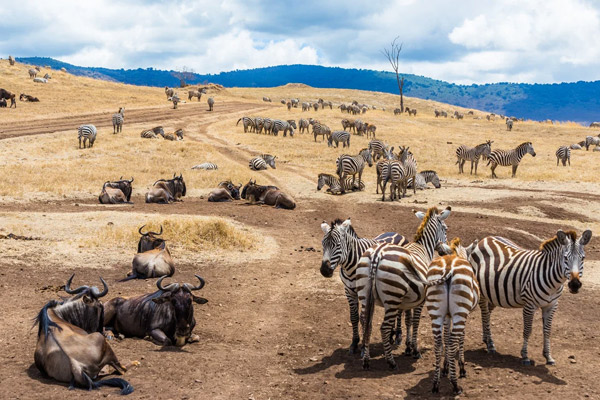Covering an area of 5700 sq miles (14,763 sq km), equal in size to Northern Ireland, the world famous Serengeti National Park is Tanzania’s oldest park, and one of the world’s last great wildlife refuges. It is contiguous with the much smaller Masai Mara Game Reservein Kenya and stretches as far as Lake Victoria to the West. Its name comes from the Maasai word Siringet, meaning ‘endless plains’.The park’s vegetation ranges from the short and long grass plains in the south, to the acacia savannah in the center and wooded grasslands concentrated around the tributaries of the Grumenti and the Mara rivers in the park. The western corridor is a region of wooded highland and extensive plains reaching the edge of Lake Victoria. In the early morning and evening light, the Serengeti landscape is stunningly beautiful.
The annual migration into Kenya (in a continuous search of water and pasture) of more than 1.5 million wildebeest and hundreds of thousands of zebra and gazelle is triggered by the rains and usually starts in May, at the end of the wet season. Called the Great Migration, this constitutes the most breathtaking event in the animal kingdom ever known to humans. As the dry season intensifies, the herds drift out towards the west, one group to the north (to Lake Victoria, where there is permanent water), the other northeast heading for the permanent waters of the northern rivers and the Mara. The immigration instinct is so strong that animals die in the rivers as they dive from the banks into the raging waters to be dispatched by crocodiles. The survivors concentrate in Kenya’s Maasai Mara National Reserve until the grazing there is exhausted, when they turn south along the eastern and final stage of the migration route.Covering an area of 5700 sq miles (14,763 sq km), equal in size to Northern Ireland, the world famous Serengeti National Park is Tanzania’s oldest park, and one of the world’s last great wildlife refuges. It is contiguous with the much smaller Masai Mara Game Reserve in Kenya and stretches as far as Lake Victoria to the West.
The annual migration into Kenya (in a continuous search of water and pasture) of more than 1.5 million wildebeest and hundreds of thousands of zebra and gazelle is triggered by the rains and usually starts in May, at the end of the wet season. Called the Great Migration, this constitutes the most breathtaking event in the animal kingdom ever known to humans. As the dry season intensifies, the herds drift out towards the west, one group to the north (to Lake Victoria, where there is permanent water), the other northeast heading for the permanent waters of the northern rivers and the Mara. The immigration instinct is so strong that animals die in the rivers as they dive from the banks into the raging waters to be dispatched by crocodiles. The survivors concentrate in Kenya’s Maasai Mara National Reserve until the grazing there is exhausted, when they turn south along the eastern and final stage of the migration route.

Choose a destination, pick your lodges, and we'll do the rest


© 2024 All Rights Reserved. Emnel Adventures Developed By Safari Marketing Pro